Pickleball’s popularity is skyrocketing, and with it, the competition’s getting fiercer. Whether you’re a beginner or aiming to dominate the court, mastering your footwork is key. It’s not just about hitting the ball; it’s how you move to hit it that often decides the game.
Importance of footwork in pickleball
In the world of pickleball, there’s a golden rule that seasoned players often share with novices: “It’s not just the power of the paddle, but the agility of your feet that wins games.” This adage encapsulates the essence of why footwork is not just important but crucial in pickleball. The game involves quick, sharp movements and rapid changes in direction. Having a strong arm can serve well, but without nimble footwork, players may find themselves struggling to keep up on the court.
Footwork in pickleball is the foundation upon which all other skills are built. Whether it’s reaching a wide shot, getting into position for a powerful return, or executing a delicate dink, how a player moves determines their level of play. Great footwork enhances reaction times, enabling players to cover more of the court with fewer steps. This efficiency in movement is not just about speed; it’s about being in the right place at the right time.
Studies show that players who prioritize footwork in their training see significant improvements in their game. Consider these documented benefits:
| Benefit | Impact on Game |
|---|---|
| Increased Court Coverage | Players can return more shots and defend better. |
| Improved Balance and Posture | Leads to more consistent and powerful shot-making. |
| Enhanced Endurance and Speed | Allows players to maintain high performance longer. |
These improvements underscore the ripple effect of good footwork—it touches every aspect of the game, from defensive maneuvers to offensive strategies.
Drills that focus on lateral movement, quick changes in direction, and endurance are particularly beneficial. They condition the body to react instinctively, reducing the mental load during play. This kind of muscle memory is invaluable, especially in high-pressure situations where every second counts.
Moreover, players who master footwork find that they experience fewer injuries. Proper movement reduces the strain on muscles and joints, protecting the body from the wear and tear common in racket sports. This aspect is particularly important for players of all ages, ensuring that they can enjoy the game for years without being sidelined by injuries.
Understanding the fundamentals of footwork
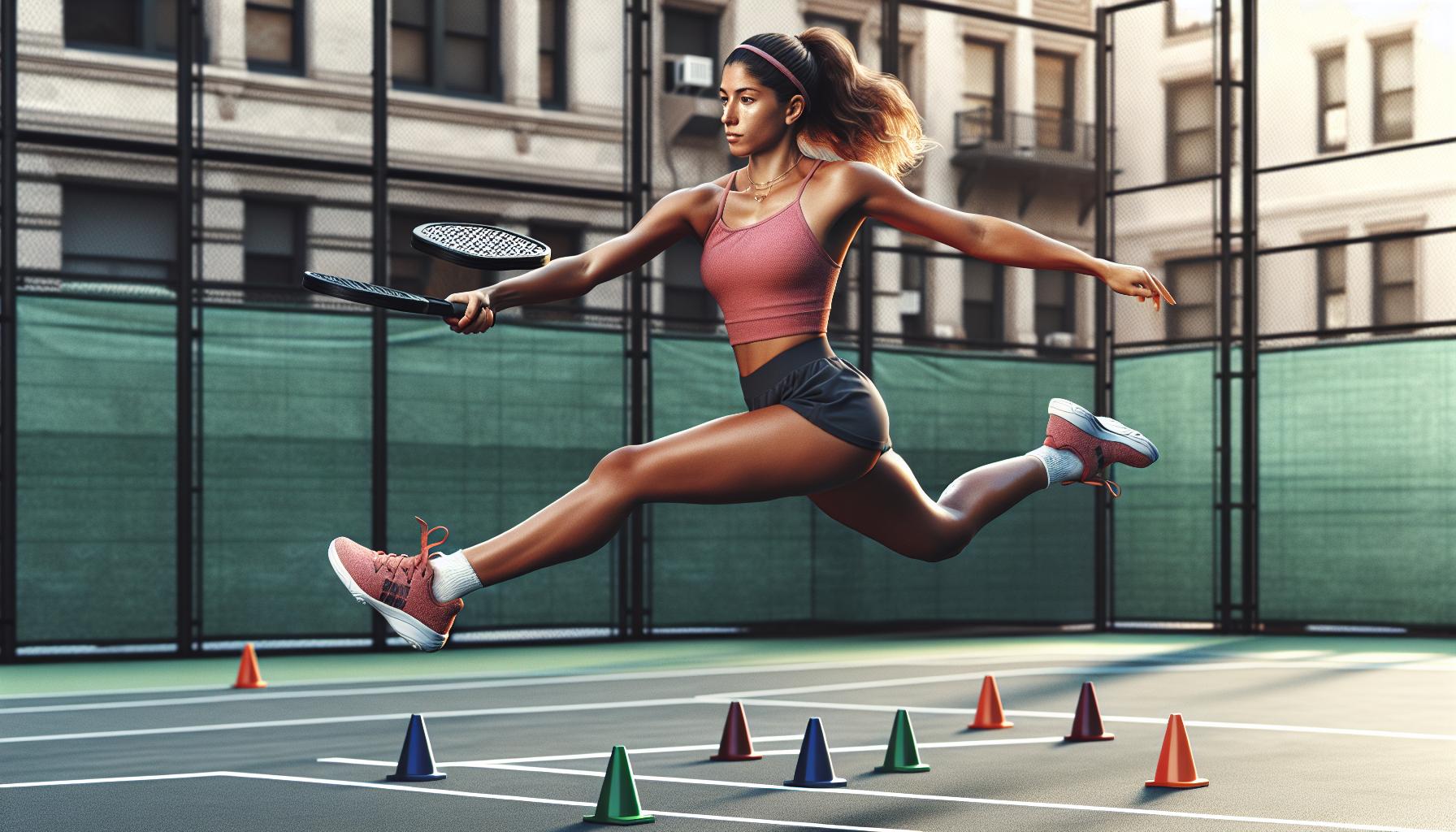
Before diving into the specifics of footwork drills, it’s essential to grasp the fundamentals that make solid footwork a game-changer in pickleball. At its core, footwork isn’t just about moving your feet quickly; it’s about moving them smartly. Optimal movement on the court means being able to anticipate the ball’s direction, react swiftly, and position oneself in the best possible spot to make a return. This requires agility, balance, and above all, a deep understanding of the game’s dynamics.
Players who master the basics of footwork gain a significant advantage over their opponents. They’re not just chasing the ball; they’re strategically placing themselves in positions where they have the best chance of making a powerful and accurate shot. Good footwork also reduces the amount of energy expended moving around the court, which is crucial in long matches where endurance becomes a factor.
Key Components of Effective Footwork
There are several key components that contribute to effective footwork in pickleball:
- Agility: This refers to the ability to change direction quickly without losing balance. Agility drills can help players improve their reaction time and make rapid directional changes more fluidly.
- Balance: Maintaining balance is crucial, especially when reaching to make a shot. Players should work on drills that improve their core strength and ability to stay grounded while moving quickly.
- Coordination: Footwork isn’t just about the feet; it involves the entire body working in harmony. Drills that enhance hand-eye coordination and the ability to sync paddle movements with footwork are fundamental.
- Endurance: Lasting through long points and matches requires good cardiovascular condition and muscular endurance. Incorporating endurance training can help players maintain optimal footwork even when fatigued.
The Role of Muscle Memory
An often overlooked aspect of developing effective footwork is the role of muscle memory. Repeating specific movements during practice helps the body instinctively know how to respond during a game. This reduces the mental load on players, allowing them to focus more on strategy and less on the mechanics of movement. By incorporating repetitive footwork drills into their training, players can develop a natural, effortless flow on the court.
Warm-up drills to improve footwork
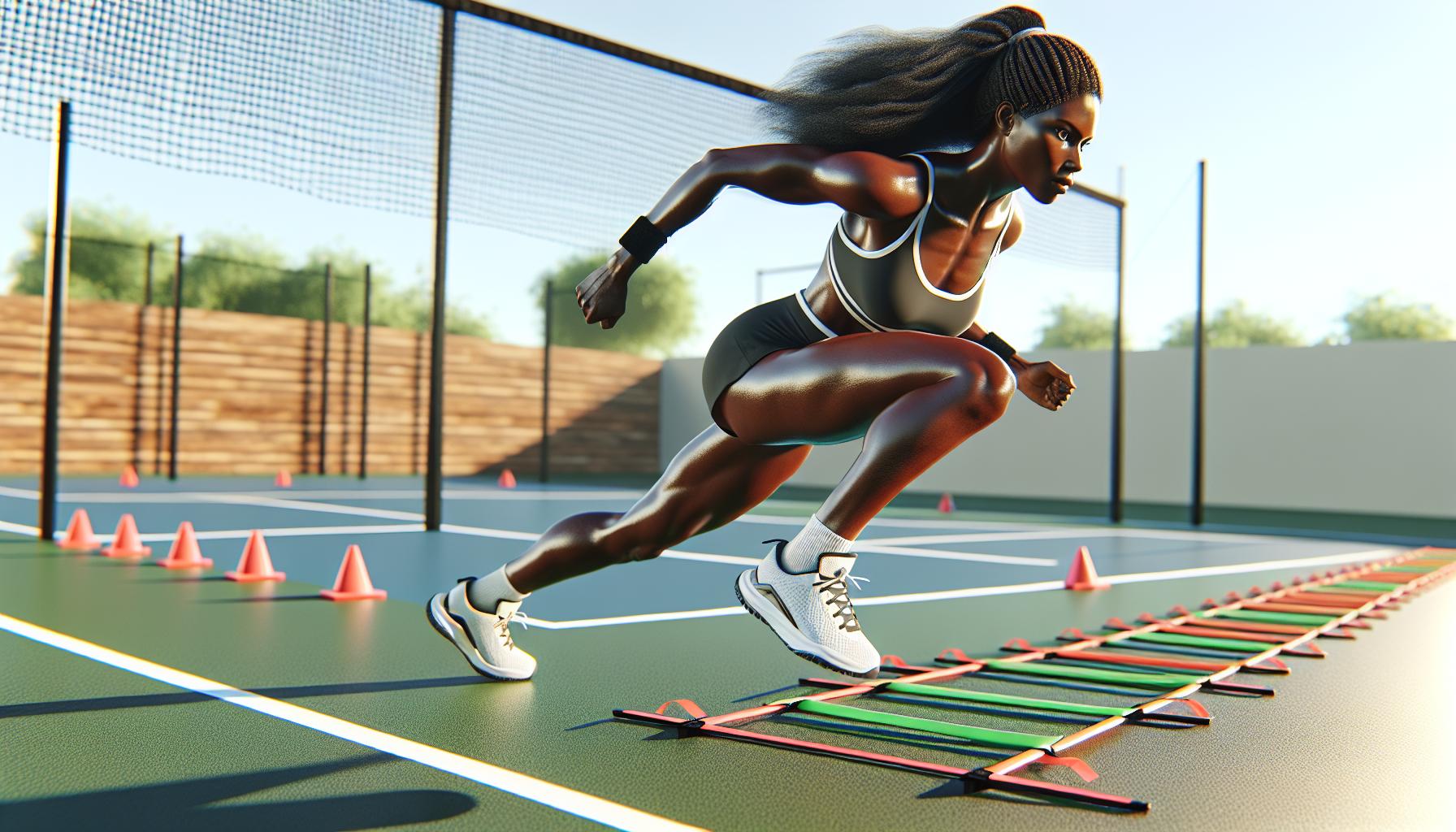
Before diving into intensive footwork drills for pickleball, it’s crucial to warm up the muscles and get the blood flowing. Warm-up drills not only prepare the body for more rigorous activity but also lay the groundwork for improving agility, balance, and coordination on the court. These exercises are designed to be low-impact yet effective in enhancing a player’s mobility and responsiveness.
Skipping Rope
A classic yet powerful warm-up, skipping rope does wonders for footwork. It enhances cardiovascular fitness, coordination, and the ability to maintain a rhythmic movement. Just a few minutes can significantly increase heart rate and core temperature, making muscles more pliable and ready for action. Additionally, it’s a fantastic way to develop the ankle’s stability and the feet’s quickness, traits critical for moving swiftly across the pickleball court.
Ladder Drills
Using an agility ladder, players can perform various drills that mimic the quick, intricate footwork needed in pickleball. Simple patterns like the single-step, where each foot lands in its square, or the in-and-out step, which challenges lateral movement, are effective. These drills not only warm up the muscles but also improve the brain’s ability to quickly send signals to the feet, enhancing overall coordination and speed.
Shadowing
This involves mirroring the movements one would make during a pickleball game without actually striking the ball. Players focus on their stance, step patterns, and court positioning. It’s an excellent way for players to mentally and physically rehearse their movements, improving their reaction times and the efficiency of their footwork. Shadowing can be done solo or with a partner, offering a dynamic and adaptable approach to warming up.
Cone Drills
Setting up cones in various patterns and running through them can dramatically improve agility and speed. Exercises like the zig-zag run or the circle drill force players to change direction quickly, developing the ability to make swift, sharp movements on the court. These drills simulate the unpredictable nature of a pickleball game, where rapid shifts in direction are common.
Dynamic Stretching
Dynamic stretches involve movement and are particularly beneficial before playing pickleball. Leg swings, hip rotations, and arm circles increase flexibility and range of motion, ensuring that players can move freely and efficiently during the game. Incorporating dynamic stretching into the warm-up routine helps prevent injuries by ensuring the body is well-prepared for the demands of the sport.
Sideways shuffle drill
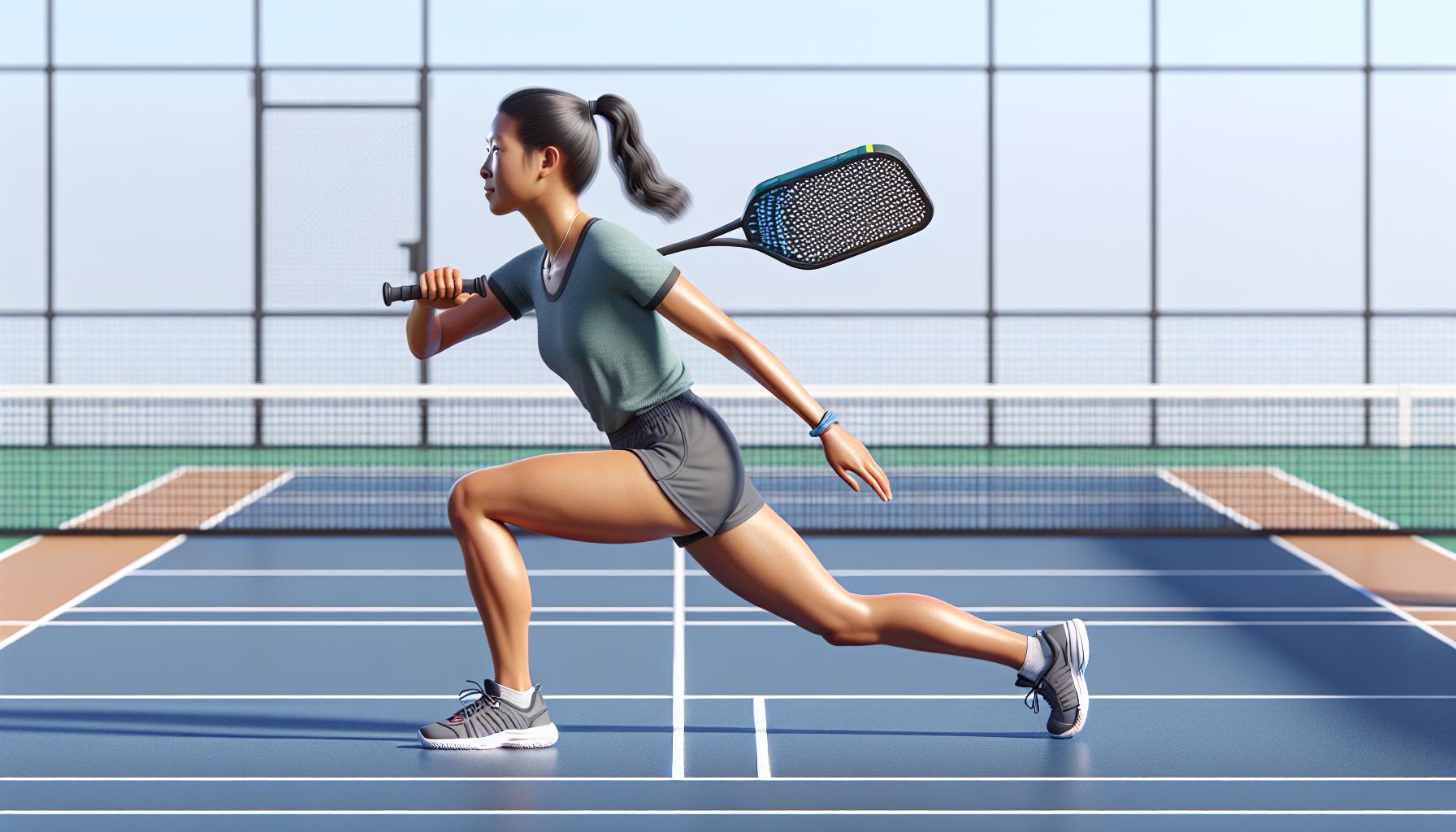
The sideways shuffle drill is a cornerstone exercise for any pickleball player aiming to boost their court coverage and agility. This drill focuses on honing lateral movement, which is crucial in pickleball where players must often move side to side quickly to effectively return shots. The beauty of this exercise lies in its simplicity and the profound impact it has on a player’s game.
To perform the sideways shuffle, players start on one side of the pickleball court. They then quickly shuffle their feet side to side, moving across the court to the opposite sideline. It’s imperative to maintain a low stance with knees slightly bent, as this promotes quick movements and helps in maintaining balance. The arms should be held in front of the body, mimicking the ready position in an actual game, to enhance coordination between footwork and paddle handling. This drill not only improves speed and agility but also aids players in learning to maintain control and balance while moving laterally.
For an increased challenge, players can incorporate changes in direction into the sideways shuffle drill. After reaching one sideline, instead of stopping, players immediately change direction and shuffle back to the starting point. This variation not only boosts endurance but also simulates the quick directional changes required during a game. Adding a paddle to the drill and having a coach or partner toss a ball in different directions can further enhance its effectiveness. This variation forces players to integrate their improved footwork with actual shot making, bringing them closer to the dynamic requirements of a pickleball match.
Key Tips for Success:
- Keep Feet Wide Apart: This prevents tangling of the legs and ensures stability.
- Move Quickly but Controlled: Speed is crucial, but losing control negates the benefits of the drill.
- Stay Low: Maintaining a low center of gravity improves balance and readiness.
- Engage the Core: This provides additional stability and aids in smoother directional changes.
Incorporating the sideways shuffle drill into a regular training routine can lead to significant improvements in a player’s ability to cover the court. As agility and speed increase, players find themselves reaching balls they previously thought were unreturnable. Additionally, the improved coordination and balance allow for more powerful and accurate shots, even when on the move.
Cross-step drill
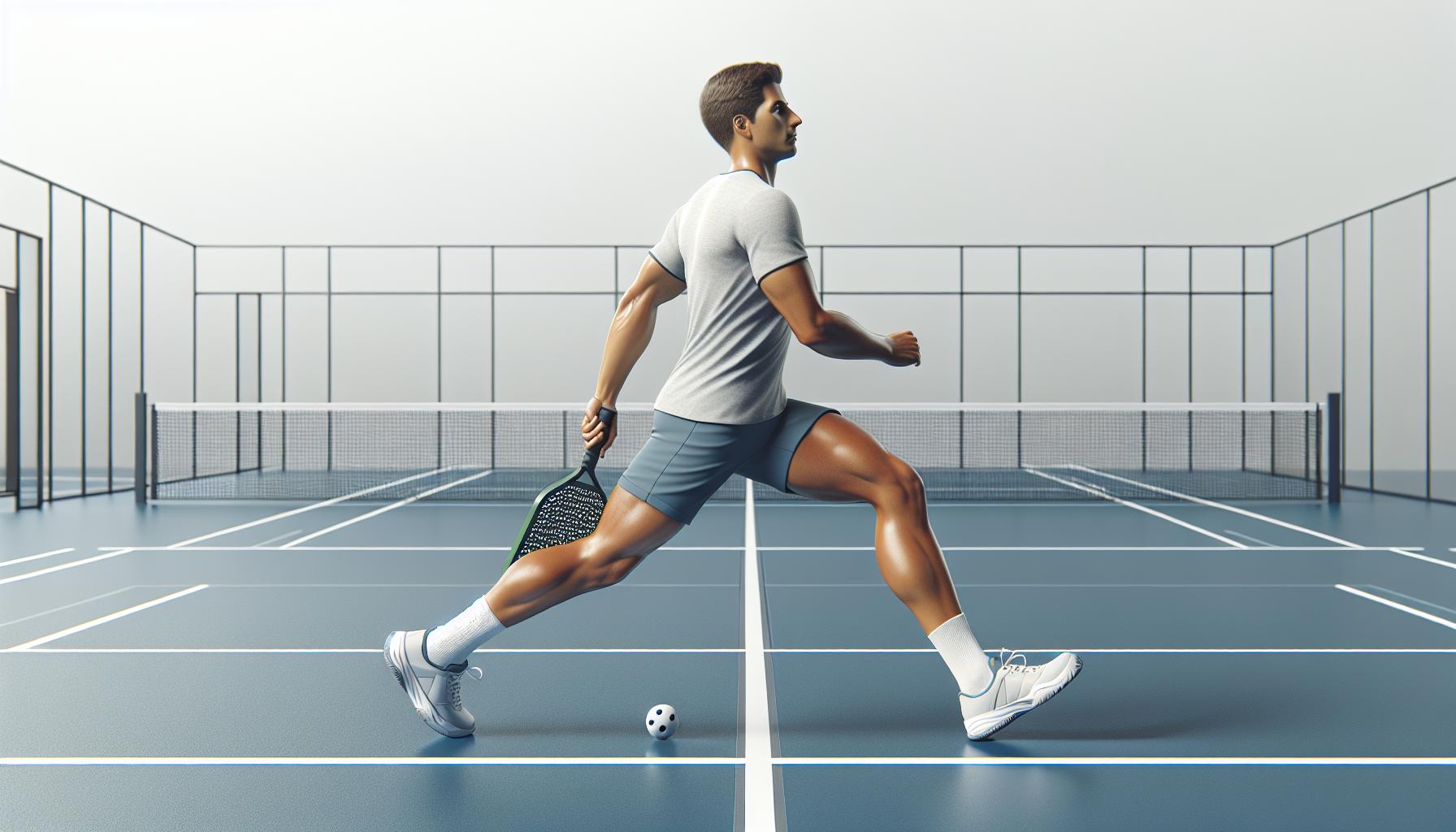
Moving seamlessly from sideways shuffles, the cross-step drill stands out as another impactful exercise that advances a player’s quickness and fluidity on the pickleball court. This drill zeroes in on the critical ability to effectively cross one’s feet over and under in a rapid, controlled manner. It’s especially beneficial when needing to cover large areas of the court quickly, making it indispensable for reaching balls that seem just out of reach.
To execute the cross-step drill, a player starts on one side of the pickleball court. They then cross one foot over the other, leading with the foot closest to the direction they intend to move first. The key is to perform these steps smoothly without losing balance, ensuring the player can quickly shift directions or prepare for a shot. The drill should be practiced in both directions to develop agility and speed evenly on both sides of the body.
Benefits of the Cross-Step Drill include:
- Improved lateral movement: By working on the crossover step, players can move across the court more swiftly.
- Increased court coverage: This drill helps players extend their reach, making it easier to get to those distant shots.
- Enhanced footwork flexibility: Practicing cross-steps empowers players to adapt their movements to various in-game situations.
Incorporating a paddle into this drill can simulate a real-game scenario more closely. Players can hold their paddle ready as they perform the cross-step, adding mock swings at the end of each movement. This addition ensures that not only do their feet move well, but their hands remain synchronized with their footwork. Over time, this coordination translates into faster, more instinctive reactions during actual gameplay.
Like the sideways shuffle, variations of the cross-step drill can be introduced to keep the exercise challenging and engaging. For example, players can include sudden stops or changes in direction at the sound of a whistle or command. These variations push the player to maintain focus and balance, vital components for excelling in pickleball. Another variation involves setting up cones or markers that the player must navigate around using the cross-step method, further enhancing their agility and spatial awareness.
Split-step drill

Continuing with the theme of enhancing agility and quickness on the pickleball court, the split-step drill emerges as a pivotal exercise for players aiming to boost their reactive capabilities. This drill centers on a preventive stance and movement, allowing players to respond more effectively to their opponent’s shots. The essence of the split-step is to elevate slightly off the ground just as the opponent strikes the ball, landing in a well-balanced position with feet shoulder-width apart. This readied stance empowers players to swiftly move in any direction, making it easier to cover the court and return shots with precision.
The beauty of the split-step drill lies in its simplicity and its profound impact on a player’s game. By incorporating this drill into their regular practice sessions, players can significantly improve their timing and anticipation skills. It’s essential for players to focus on the timing of the jump – too early or too late, and they won’t benefit from the split-step’s agility-boosting effects. Practicing the split-step in various scenarios, such as after serving or when preparing to volley, can help players get accustomed to incorporating this move during actual games.
Key Benefits of the Split-Step Drill:
- Enhanced Reaction Time: Prepares players mentally and physically to react swiftly.
- Better Court Coverage: Improves ability to move quickly in all directions, reaching more shots.
- Increased Stability and Balance: Promotes a balanced landing that’s crucial for subsequent quick movements.
To effectively practice the split-step drill, players should start by watching their opponent’s paddle closely as it makes contact with the ball. At that precise moment, they execute a small jump, landing softly on the balls of their feet, ready to propel themselves towards the ball. It’s critical to keep the knees bent and the body low to maintain agility. Coaches often recommend practicing this drill with a partner to simulate real game situations, enhancing the drill’s effectiveness in improving court dynamics.
For an added challenge, players can incorporate variations into the drill. Adding a directional move immediately after landing from the split-step, for example, can mimic actual game scenarios more closely. This could involve moving forward to net a volley, stepping back to handle a deep shot, or moving side to side to return a crosscourt hit. These variations not only improve physical agility but also sharpen decision-making skills, as players learn to quickly assess and react to different shots.
Backward movement drill
Transitioning smoothly from drills accentuating forward and lateral agility, the backward movement drill addresses an equally essential aspect of court mobility in pickleball. It focuses on developing the player’s ability to move quickly and safely backward, a skill crucial when retrieving deep shots or adjusting positioning. This drill complements the previously discussed exercises by emphasizing balance and speed during rearward navigation, ensuring players are prepared for a full range of movement on the court.
The premise of the backward movement drill is straightforward yet effective. Players begin by standing at the net and then move rapidly backward to the baseline upon their coach’s or partner’s cue. The key is to maintain a low center of gravity, with knees slightly bent, ensuring stability. Players should avoid crossing their feet, as this increases the risk of tripping and reduces speed. Instead, they should step back in a smooth, controlled manner, using their peripheral vision to stay aware of their surroundings. This drill not only enhances backward mobility but also trains players to remain focused and poised under pressure.
- Balance and Stability: Keeping the body low with knees bent improves balance, making it easier to move swiftly in any direction.
- Eyes Forward: Even when moving backward, players should keep their eyes forward, enabling them to anticipate their opponent’s next shot.
- Step Size: Small, quick steps are more effective than larger leaps, which can lead to loss of balance and slower movement.
Implementing this drill into regular training sessions can significantly impact a player’s game. By mastering backward movement, players will find themselves more adept at covering the entire court, especially against opponents who favor deep shots. Furthermore, it diminishes the hesitation or discomfort some might feel when forced to move away from the net, thus expanding their defensive capabilities.
For an added challenge, coaches can incorporate a ball-feeding component into the drill. As players move backward, a coach or training partner can feed balls at varying depths and angles, forcing the player to adapt their backward movement in real-time to hit back effectively. This variation introduces a realistic element to the drill, simulating the unpredictable nature of actual game play. Additionally, it encourages players to adjust their stroke mechanics while on the move, fostering a more versatile playing style.
Quick reaction drill
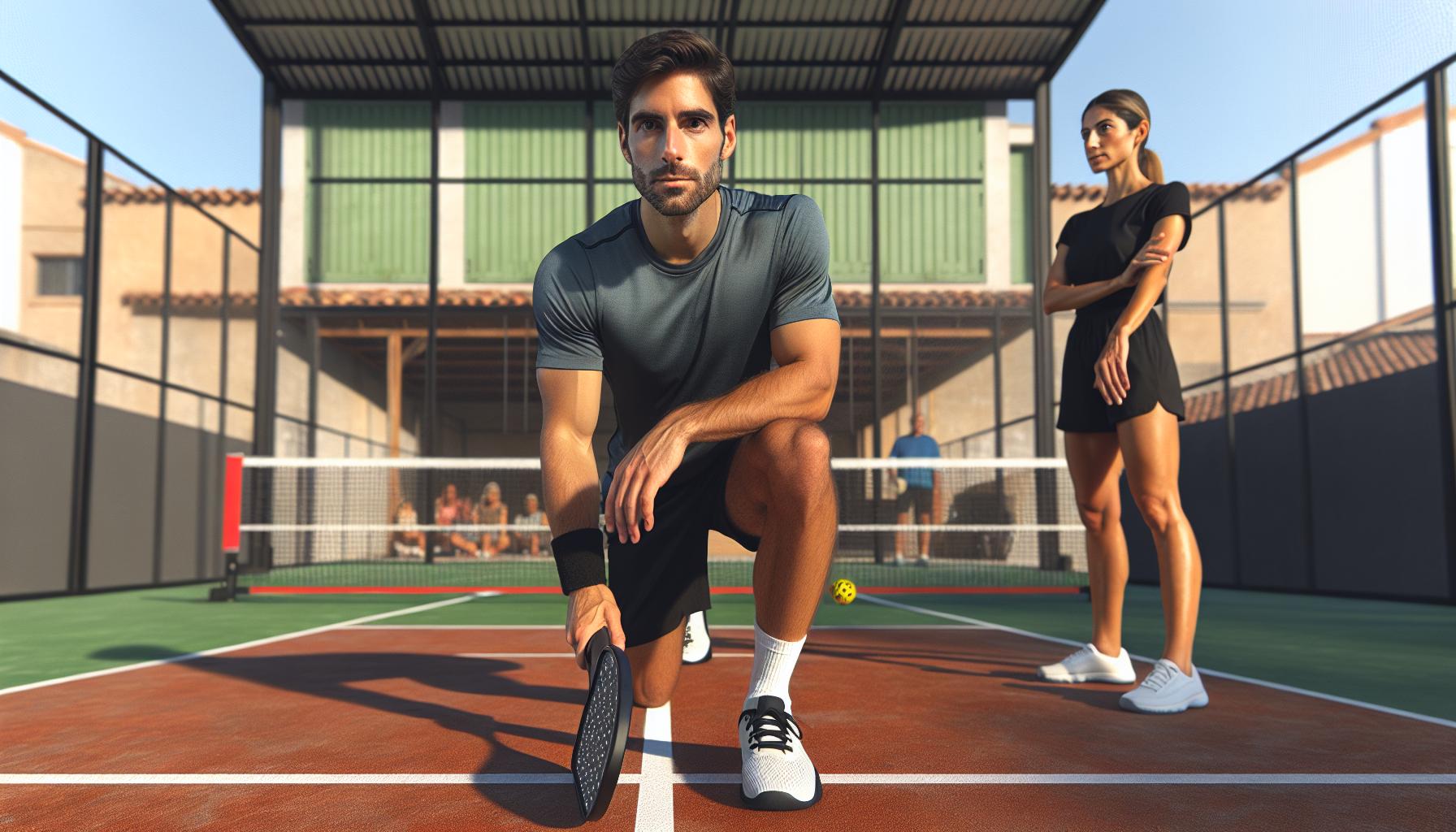
The quick reaction drill stands out as a critical exercise for enhancing a player’s responsiveness on the pickleball court. This drill is designed to sharpen players’ reflexes, allowing them to react swiftly to unexpected shots. It involves a series of rapid movements, responding to a coach’s or partner’s cues, which can be verbal, visual, or through the direction of a hit ball. The key to success in this drill is the unpredictability, simulating the spontaneity of real-match scenarios.
Players start the drill in a ready position, feet shoulder-width apart, knees slightly bent, paddle in front of them. The coach or a partner then provides cues at random intervals, directing players to move in specific directions or to specific locations on the court. The cues can include movements like quick sprints forward, backward, or to the sides, emphasizing the need for quick stops and explosive changes in direction. This unpredictability mimics the dynamic nature of pickleball, where players must constantly adjust their positioning based on the flow of the game.
To increase the challenge and effectiveness of the quick reaction drill, additional elements can be incorporated:
- Multi-ball drills where multiple balls are fed in rapid succession, forcing players to reset and react quickly after each shot.
- Auditory cues might be used instead of visual ones, requiring players to react based on what they hear, demanding high levels of concentration and mental agility.
- Directional changes on cue, where players must instantly decide the most efficient footwork pattern to adapt and respond to the play.
The benefits of integrating the quick reaction drill into regular practice routines are manifold. It significantly:
| Benefit | Impact on Player |
|---|---|
| Enhanced Reactivity | Enables faster response to sudden plays |
| Improved Decision-Making | Helps in choosing optimal footwork quickly |
| Increased Agility | Promotes rapid starts and stops, critical for game-play |
| Better Mental Focus | Trains players to maintain concentration under pressure |
Through repetition, players develop an instinctual ability to read the game and respond effectively, a skill that proves invaluable during competitive matches. Coaches emphasize the importance of relaxation and breathing techniques during the drill, as tension can slow down reaction time. Players learn to remain calm and focused, a state that greatly enhances their performance on the court.
Conclusion
Mastering footwork in pickleball isn’t just about moving faster; it’s about moving smarter. Through the drills outlined, players can build a solid foundation of agility, balance, coordination, and endurance. Each drill, from the sideways shuffle to the quick reaction exercises, is designed to refine the movements that make a significant difference on the court. By incorporating these drills into their training, players will not only see improvements in their game but also enjoy a reduced risk of injury, ensuring they can continue playing the sport they love for years to come. Remember, great footwork isn’t just a skill—it’s your secret weapon in the fast-paced world of pickleball. So lace up those sneakers, hit the court, and start moving your way to pickleball prowess.

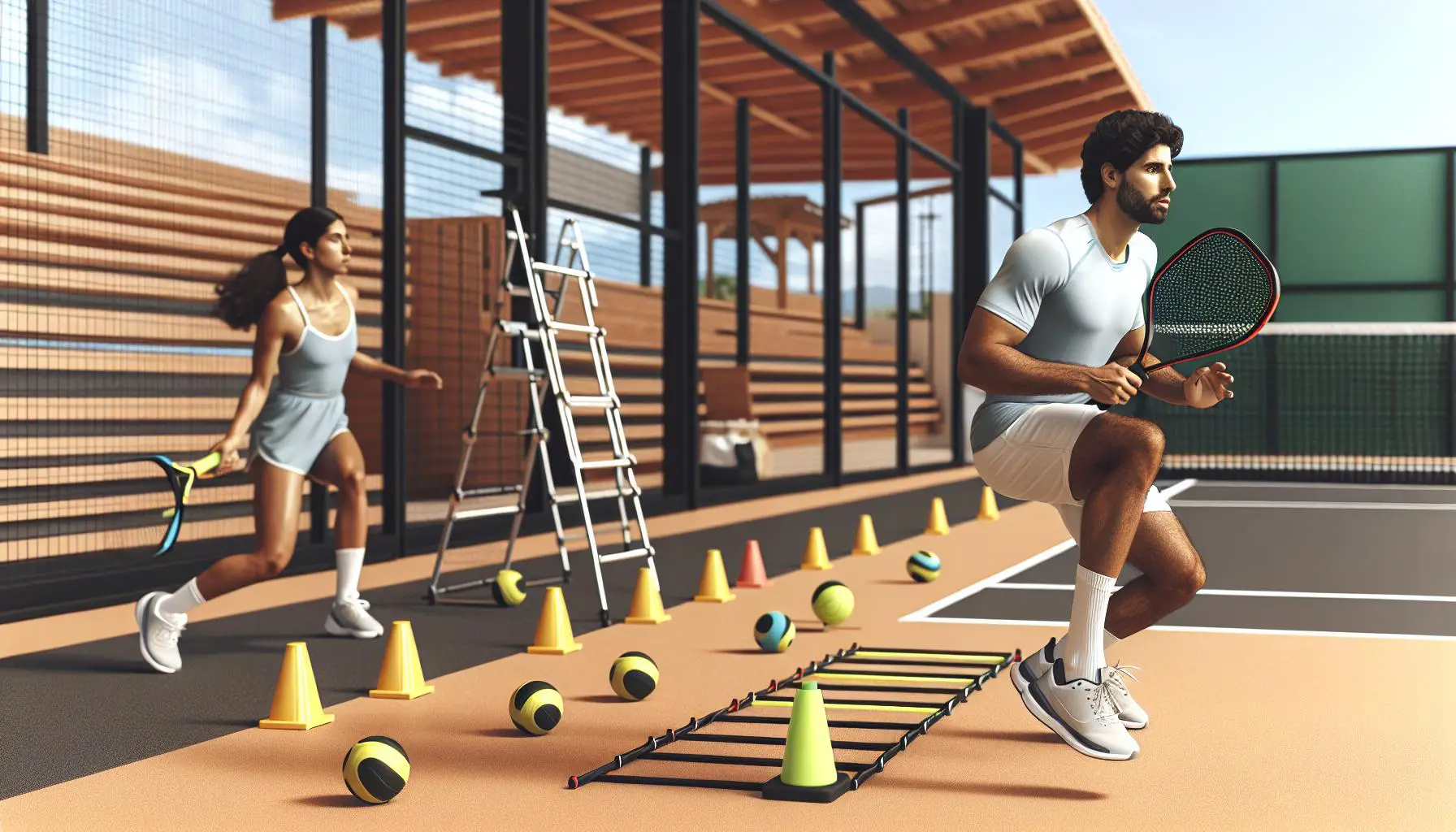









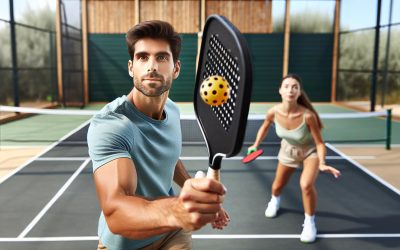
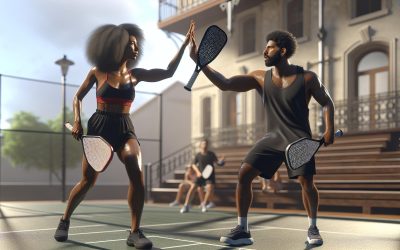

0 Comments